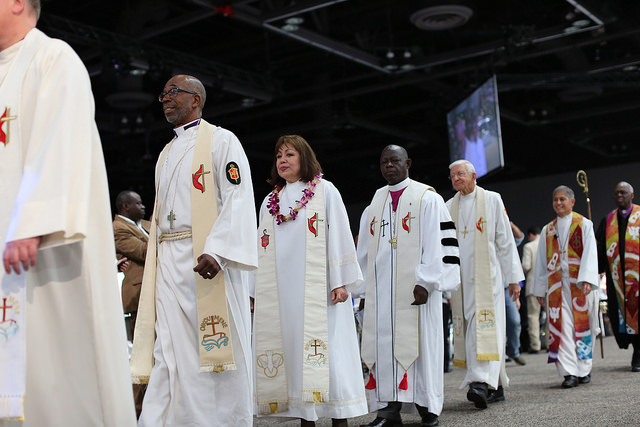Before this time next week The United Methodist Church will consecrate 15 new bishops and here's the work that lies ahead.
HEATHER HAHN
United Methodist News Service
While the U.S. political scene focuses on who is winning red and blue states, many United Methodists are preparing to vote on who will wear the purple.
Starting July 13, the five U.S. jurisdictional conferences will elect a total of 15 bishops. The gatherings also will finalize the next assignments for a number of already active episcopal leaders. In addition, two of the meetings will take up proposals on consolidating conference boundaries.
Central conferences — United Methodist regions in Africa, Europe and the Philippines — have elections scheduled later in 2016 and in early 2017.
So far, at least 55 clergy in the United States have announced their candidacy for bishop. In some jurisdictions, delegates also can nominate candidates from the floor.
The United Methodists who vote on bishops include General Conference delegates and other church leaders.
Each conference elects twice as many delegates to jurisdictional conferences as they do to the denomination’s top lawmaking body. That means a total of 1,008 delegates will vote in this month’s U.S. bishop elections. The delegates include an equal number of laity and clergy.
All newly elected U.S. bishops will take office Sept. 1.
Here are details about the jurisdictional gatherings:
- The Southeastern Jurisdiction will elect five bishops when it meets July 13-15 at Lake Junaluska, North Carolina.
- The North Central Jurisdiction will elect four bishops when it meets July 13-16 in Peoria, Illinois. The meeting also will vote on the plan to join the Detroit and West Michigan conferences into a new Michigan Conference. These conferences already share a bishop.
- The South Central Jurisdiction will elect three bishops when it meets July 13-16 in Wichita, Kansas.
- The Northeastern Jurisdiction will elect two bishops when it meets July 11-15 in Lancaster, Pennsylvania. Because of declining membership, the jurisdiction had faced a possible reduction in bishops. However, General Conference 2016 opted to keep the same number of U.S. bishops while the denomination studies denominational borders.
- The Western Jurisdiction will elect one bishop when it meets July 13-16 in Scottsdale, Arizona. The meeting also will vote on a proposal from the Rocky Mountain and Yellowstone conferences to continue working toward forming one, new conference. As is the case in Michigan, these conferences in the U.S. Mountain West already share a bishop.
What bishops do
United Methodist bishops do not wear miters or special robes. Their main distinctive garment is a simple purple clergy shirt. While limited in fashion choices, bishops do wear multiple hats, metaphorically speaking.
Bishops are elders “set apart for a ministry of servant leadership, general oversight and supervision,” states the Book of Discipline, the denomination’s governing document.
United Methodist bishops appoint clergy. They also are the first stop when clergy face complaints under church law.
They oversee general church agencies as board members and sometimes agency presidents. They represent the denomination in ecumenical and interfaith relationships. They also frequently represent the church in the wider community and before state and national governments.
Impact on sexuality commission
This new class of bishops, at least in the near future, will have an additional task.
General Conference 2016 in May gave the Council of Bishops authority to name a special commission that will review and possibly recommend revisions to church teachings related to human sexuality. The lawmaking assembly also voted to hit the pause button on the sexuality debate during the gathering.
The bishops are considering calling a special General Conference in 2018 or 2019 to take up the commission’s work.
The hope is to keep a deeply divided denomination united.
The Book of Discipline, since 1972, has stated that all people are of sacred worth, but the church considers the practice of homosexuality “incompatible with Christian teaching.” The church bans pastors from officiating at same-gender weddings and bans the ordination of “self-avowed practicing” gay clergy.
However, debate has intensified in recent years, and in the month since General Conference, a number of U.S. conferences have declared that they will not conform to these bans. Three of the U.S. bishop candidates are openly gay.
At this point, the Council of Bishops has tasked its 17-member executive committee with developing a process to appoint the human-sexuality commission and creating a timeline for the commission’s work. The executive committee is scheduled next to meet the week after jurisdictional conferences.
Newly elected bishops eventually will also have a say in what happens with the bishops’ proposed “Way Forward.”
“This new class of bishops will bring important perspective and experience to the council's work related to implementing the proposal,” said Dakotas-Minnesota Area Bishop Bruce Ough, the Council of Bishops president.
Last Updated on November 8, 2023

